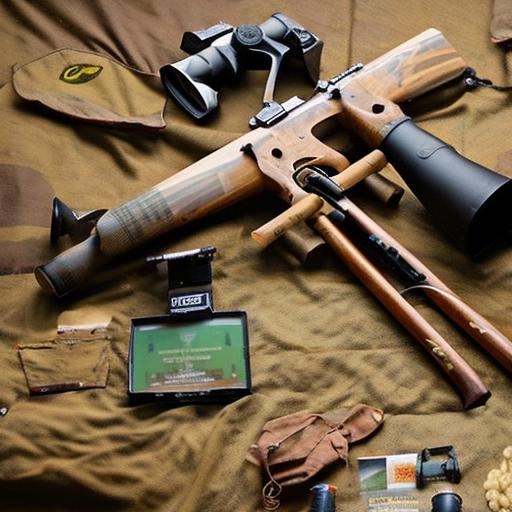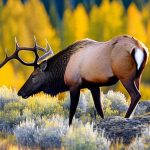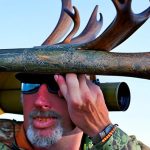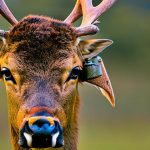Your cart is currently empty!

Essential Elk Hunting Gear List: Be Prepared for a Successful Hunt

Elk hunting is a popular and challenging outdoor activity that requires proper gear to ensure a successful and safe experience. Whether you are a seasoned hunter or a beginner, having the right equipment is essential. From clothing to boots, backpacks to optics, rifles to calls, and knives to accessories, each piece of gear plays a crucial role in your elk hunting adventure. In this article, we will explore the importance of each item and provide insights into choosing the right gear for your needs.
Key Takeaways
- Proper clothing is crucial for elk hunting, including layers, camouflage, and weather-resistant materials.
- Essential hunting boots for elk hunting should be sturdy, waterproof, and provide good traction on rough terrain.
- Choosing the right hunting backpack for elk hunting involves considering size, weight, and features like hydration systems and compartments for gear.
- The best optics for elk hunting include binoculars and scopes with high magnification and clear lenses.
- Elk hunting rifles and ammunition require careful consideration of factors like caliber, bullet weight, and accuracy.
- Elk hunting calls are a key tool for attracting and communicating with elk during the hunt.
- Scent control is important in elk hunting to avoid alerting elk to your presence and reducing the chance of spooking them.
- Choosing the right elk hunting knife involves considering blade size, shape, and material for field dressing and processing game.
- Elk hunting accessories like GPS devices, headlamps, and first aid kits can be essential for a successful and safe hunt.
- Safety gear for elk hunting includes items like bear spray, a compass, and a whistle to protect yourself in the wilderness.
The Importance of Proper Clothing for Elk Hunting
When it comes to elk hunting, proper clothing is essential for comfort, protection, and concealment. Layering is key to regulating body temperature in changing weather conditions. Start with a moisture-wicking base layer to keep sweat away from your skin. Add an insulating mid-layer for warmth and an outer layer for protection against wind, rain, and snow. Opt for clothing made from breathable and waterproof materials to stay dry and comfortable throughout your hunt.
Camouflage clothing is another important aspect of elk hunting gear. It helps you blend into the natural surroundings and increases your chances of getting close to elk without being detected. Choose camouflage patterns that match the terrain you will be hunting in, such as woodland or mountain patterns. Additionally, consider investing in a camouflage face mask and gloves to further conceal your presence.
Essential Hunting Boots for Elk Hunting
Elk hunting often involves long hikes through rough and uneven terrain. Therefore, having comfortable and durable boots is crucial. Look for boots that provide excellent ankle support to prevent injuries on uneven ground. Opt for waterproof boots to keep your feet dry in wet conditions.
There are different types of hunting boots available, including insulated boots for cold weather hunts and lightweight boots for warmer climates. Insulated boots are ideal for late-season hunts when temperatures drop below freezing. Lightweight boots are suitable for early-season hunts when temperatures are milder.
Choosing the Right Hunting Backpack for Elk Hunting
| Backpack Brand | Capacity (Liters) | Weight (lbs) | Frame Type | Price Range |
|---|---|---|---|---|
| Badlands Superday | 28 | 3.5 | Internal | 200-300 |
| Mystery Ranch Metcalf | 71 | 5.6 | External | 500-600 |
| Eberlestock X2 | 22 | 4.5 | Internal/External | 200-300 |
| Tenzing TZ 1250 | 20 | 4.5 | Internal | 200-300 |
| Stone Glacier Sky 5900 | 95 | 6.9 | External | 700-800 |
A good hunting backpack is essential for carrying all your gear and supplies during an elk hunt. Look for a backpack that is spacious, durable, and comfortable to wear for long periods. Consider the weight distribution and padding on the shoulder straps and waist belt to ensure maximum comfort.
Different types of backpacks offer various features to suit different hunting styles. Some backpacks come with a built-in hydration system, allowing you to stay hydrated without having to carry a separate water bottle. Others have multiple compartments and pockets for organizing your gear efficiently. Choose a backpack that meets your specific needs and preferences.
The Best Optics for Elk Hunting
Having good optics is crucial for spotting and tracking elk from a distance. Binoculars and scopes are essential tools for elk hunting. Look for binoculars with a magnification power of at least 8x or 10x and an objective lens diameter of 42mm or larger. This will provide you with a clear and detailed view of the surrounding area.
Scopes are used for precise aiming when shooting at longer distances. Look for scopes with variable magnification settings and a large objective lens diameter for better light transmission in low-light conditions. Consider factors such as reticle type, eye relief, and durability when choosing a scope.
Elk Hunting Rifles and Ammunition: What You Need to Know

Choosing the right rifle and ammunition is crucial for a successful elk hunt. Elk are large animals, so you need a rifle that can deliver enough power to take them down effectively. Look for rifles chambered in calibers such as .270 Winchester, .30-06 Springfield, or .300 Winchester Magnum. These calibers offer sufficient power and range for elk hunting.
When it comes to ammunition, choose bullets specifically designed for big game hunting. Look for bullets that expand upon impact to create a wide wound channel and deliver maximum energy to the animal. Consider factors such as bullet weight, bullet construction, and muzzle velocity when selecting ammunition.
Elk Hunting Calls: The Key to a Successful Hunt
Elk calls are essential tools for attracting and locating elk during your hunt. There are different types of calls available, including bugle calls, cow calls, and grunt calls. Bugle calls mimic the sound of a bull elk’s bugle, which is used to establish dominance and attract cows. Cow calls imitate the sounds made by female elk to attract bulls. Grunt calls mimic the sounds made by a bull elk during the rutting season.
Using elk calls requires practice and knowledge of elk behavior. It is important to understand when and how to use each type of call effectively. Practice different calling techniques and learn to read elk behavior to increase your chances of a successful hunt.
The Importance of Scent Control in Elk Hunting
Elk have a keen sense of smell, and any human scent can alert them to your presence. Therefore, minimizing human scent is crucial for a successful elk hunt. There are various scent control products and techniques available to help you achieve this.
Start by washing your hunting clothes with scent-free detergent and storing them in a scent-free bag or container. Use scent-free body wash, shampoo, and deodorant before heading out into the field. Consider using scent-eliminating sprays or cover scents to further mask your scent.
Elk Hunting Knives: Choosing the Right Blade for the Job
A good hunting knife is essential for field dressing and processing an elk after a successful hunt. Look for a knife with a fixed blade as they are more durable and reliable than folding knives. Choose a blade length that suits your needs, typically between 3 to 5 inches.
Consider the type of blade steel when choosing a hunting knife. Stainless steel blades are resistant to corrosion but may be harder to sharpen. Carbon steel blades are easier to sharpen but require more maintenance to prevent rusting.
Elk Hunting Accessories: What You Need to Bring Along
In addition to the essential gear mentioned above, there are other accessories that can enhance your elk hunting experience. A GPS device is essential for navigation and marking important locations such as your campsite or a successful kill site. A headlamp is crucial for hands-free illumination during early morning or late evening hunts. A first aid kit is essential for treating minor injuries or emergencies in the field.
Other accessories to consider include a range finder for accurate distance measurement, shooting sticks for stability when taking long-range shots, and a game cart or pack frame for transporting meat and gear.
Safety Gear for Elk Hunting: Protecting Yourself in the Wilderness
Safety should always be a top priority when elk hunting. In addition to the essential gear mentioned above, there are specific safety items you should bring along. Bear spray is essential for protection against potential bear encounters. An emergency whistle can be used to signal for help in case of an emergency.
Other safety precautions to take while elk hunting include informing someone of your hunting plans and expected return time, carrying a map and compass for navigation, and familiarizing yourself with the area’s regulations and hunting seasons.
Proper gear is essential for a successful and safe elk hunting experience. From clothing to boots, backpacks to optics, rifles to calls, knives to accessories, each piece of gear plays a crucial role in your hunt. By investing in high-quality gear and understanding how to use it effectively, you can increase your chances of a successful hunt while ensuring your safety in the wilderness. So, before you embark on your next elk hunting adventure, make sure you have the right gear to make the most of your experience.
If you’re an avid elk hunter, you know that having the right gear is essential for a successful hunt. But what about the other types of hunting? If you’re interested in expanding your hunting skills, you might want to check out this article on “How to Hunt Raccoons at Night Without Dogs” from Old Oak Syndicate. It’s a great resource for those looking to try their hand at raccoon hunting and offers valuable tips and techniques. So whether you’re gearing up for an elk hunt or exploring new hunting opportunities, be sure to check out this informative article. Read more here.
FAQs
What is an elk hunting gear list?
An elk hunting gear list is a comprehensive list of all the necessary equipment and gear needed for a successful elk hunting trip.
What are some essential items on an elk hunting gear list?
Some essential items on an elk hunting gear list include a hunting rifle, ammunition, binoculars, a hunting knife, a backpack, a GPS device, and appropriate clothing and footwear.
What type of clothing is recommended for elk hunting?
Clothing that is recommended for elk hunting includes layers of moisture-wicking and breathable materials, waterproof and windproof outerwear, and insulated clothing for colder weather.
What type of footwear is recommended for elk hunting?
Footwear that is recommended for elk hunting includes sturdy and waterproof hiking boots with good ankle support.
What type of hunting rifle is recommended for elk hunting?
A hunting rifle that is recommended for elk hunting is a high-powered rifle with a caliber of .270 or larger.
What type of ammunition is recommended for elk hunting?
Ammunition that is recommended for elk hunting includes bullets with a weight of 150 grains or more and a high ballistic coefficient.
What type of backpack is recommended for elk hunting?
A backpack that is recommended for elk hunting is a durable and waterproof backpack with a capacity of at least 3,000 cubic inches.
What type of hunting knife is recommended for elk hunting?
A hunting knife that is recommended for elk hunting is a sturdy and sharp knife with a blade length of at least 4 inches.
What type of GPS device is recommended for elk hunting?
A GPS device that is recommended for elk hunting is a handheld GPS device with a long battery life and the ability to mark waypoints and track routes.

Herb has been a longtime lover of the outdoors. Whether it be hunting, camping, fishing or just getting outside to reset. Proud father and animal lover. Bourbon anyone?

by
Tags:
Comments

Categories
- Big Game Hunting (301)
- Deer (202)
- Reviews (3)
- Shooting (16)
- Slingshot (1)
- Small Game Hunting (42)
- Upland Hunting (126)
- Waterfowl Hunting (3)





Leave a Reply